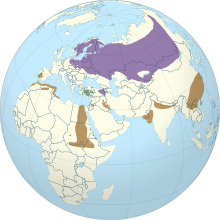
Back Grus grus AN كركي شائع Arabic كركى ARZ Grus grus AST Ipom (Grus grus) AVK Boz durna Azerbaijani Һоро торна Bashkir Gervė BAT-SMG Шэры журавель Byelorussian Шэры журавель BE-X-OLD
| Common crane | |
|---|---|

| |
| Scientific classification | |
| Domain: | Eukaryota |
| Kingdom: | Animalia |
| Phylum: | Chordata |
| Class: | Aves |
| Order: | Gruiformes |
| Family: | Gruidae |
| Genus: | Grus |
| Species: | G. grus
|
| Binomial name | |
| Grus grus | |

| |
| The range of the common crane
Extant (non-breeding)
Extant (resident)
Extant (breeding)
| |
| Synonyms | |
| |
The common crane (Grus grus), also known as the Eurasian crane, is a bird of the family Gruidae, the cranes. A medium-sized species, it is the only crane commonly found in Europe besides the demoiselle crane (Grus virgo) and the Siberian crane (Leucogeranus leucogeranus) that only are regular in the far eastern part of the continent. Along with the sandhill crane (Antigone canadensis), demoiselle crane and the brolga (Antigone rubicunda), it is one of only four crane species not currently classified as threatened with extinction or conservation dependent on the species level. Despite the species' large numbers, local extinctions and extirpations have taken place in part of its range, and an ongoing reintroduction project is underway in the United Kingdom.[3]
- ^ BirdLife International (2016). "Grus grus". IUCN Red List of Threatened Species. 2016: e.T22692146A86219168. doi:10.2305/IUCN.UK.2016-3.RLTS.T22692146A86219168.en. Retrieved 19 February 2022.
- ^ "Appendices | CITES". cites.org. Retrieved 14 January 2022.
- ^ "Common cranes 'here to stay' after recolonising eastern England". The Guardian. 17 July 2018. Retrieved 25 April 2019.
